by Lee Valentine
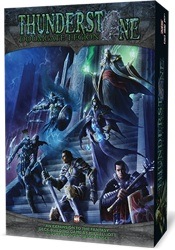 Thunderstone: Doomgate Legion
Thunderstone: Doomgate Legion
Published by Alderac Entertainment Group
Designed by Mike Elliott
Contents: 317 cards, full-color rulebook, 28 card dividers, foam storage inserts
$34.99
Doomgate Legion (DL) is the newest expansion released for
Alderac Entertainment Group's (AEG) fantasy deck-building game,
Thunderstone (TS). It expands the game with 30
randomizers, 287 other cards, and enough dividers to keep the new cards
introduced in this set organized in your collection.
Thematically, the expansion tells the story of the order of the Doomgate
Legion, which, according to AEG, is the group that guards the third
Thunderstone, "the Stone of Avarice from friend and foe alike. [...] Their
cult-like existence known only to a few, the Legionnaires dedicate
themselves to the secrecy, protection, and worship of the stone."
New Cards
DL features 13 new types of Village cards, seven new Heroes, five
new Monsters, a deck of Special Disease cards, two categories of
Treasure cards, one new Thunderstone, and one new Guardian card.
DL introduces a variety of new mechanics to TS. Among
these are a new Disease deck, "cantrip" cards, Treasure cards, and cards
that offer alternate uses for cards from earlier releases. I will
briefly address each of these new mechanics.
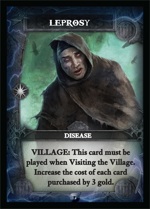 The Special Disease deck features ten standard disease cards that simply
penalize you with a -1 to your Dungeon Attack rating, but there are also
15 new special Diseases. These include a variety of debilitating
effects, from making your Village purchases more expensive to cards that
cost you Victory Points at the end of the game. Unlike traditional
Diseases, when the Special Disease deck is utilized the deck is kept
face down and Diseases are handed out at random. This means that it's a
bit tougher to blithely attack a monster that gives you a Disease card
in Battle. Two of the new monsters introduced in the set require that
you play with the Special Disease deck, but it can also be added at any
time to increase the game's difficulty and length.
The Special Disease deck features ten standard disease cards that simply
penalize you with a -1 to your Dungeon Attack rating, but there are also
15 new special Diseases. These include a variety of debilitating
effects, from making your Village purchases more expensive to cards that
cost you Victory Points at the end of the game. Unlike traditional
Diseases, when the Special Disease deck is utilized the deck is kept
face down and Diseases are handed out at random. This means that it's a
bit tougher to blithely attack a monster that gives you a Disease card
in Battle. Two of the new monsters introduced in the set require that
you play with the Special Disease deck, but it can also be added at any
time to increase the game's difficulty and length.
Among the new Village cards are a new type of card called "Mercenaries".
Some of these offer what I'll call a "cantrip effect" (a term borrowed
from Magic: The Gathering players). These cards offer you a
standard effect like a static bonus to Attack, but in both the Dungeon
and the Village they offer you the ability to draw one or more extra
cards. This is a boon compared to some other Village cards, which grant
you an effect either in the Village or the Dungeon, but not both.
One Mercenary, the Pious Chaplain is highly situational and differs from
the other Mercenaries – he is not a "cantrip effect" card. He allows
you, either in the Village or the Dungeon, to destroy any Disease cards
in your hand and draw two cards for each Disease that you destroyed.
Unfortunately, he has no alternate ability. So, unlike every other card
in the game, if your randomly selected Monster sets contain no
Disease-producing beasties, then the Pious Chaplain is an entirely dead
card that you would never select. Similarly, after you trim the other
Diseases out of your deck he serves no function whatsoever, just
clogging up your deck in a fashion that's only slightly better than the
Diseases that he is supposed to be ridding you of.
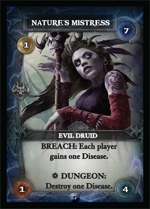 Treasure cards are nearly polar opposites of the Trap cards from the
Wrath of the Elements (WE) expansion. Treasure cards are
shuffled into the Dungeon Deck and randomly appear in the Dungeon Hall
from time to time. These cards are immediately collected by the active
player, and do not go into his deck, but are instead set in front of him
for the rest of the game until they are used. Each one grants a
one-shot game effect that can be cashed in during any future turn of the
game. Treasure cards can even be acquired when you fail to defeat a
monster, an idea that seems counter to the dungeon-delving theme. They
are an interesting addition to the game in that they encourage players
to enter the Dungeon Hall even to unsuccessfully encounter a monster,
helping to keep the Dungeon Hall from remaining too stagnant if all the
monsters are too powerful to kill. Ideally, though, Treasure cards
should have been kept separate from the Dungeon Deck and tied to a
Spoils effect of some kind on particularly difficult monsters to
encourage you to fight them. As it is, since they appear at random, I
question the game balance effects these items can have on the game, but
as their effects are modest and one-shot in nature, I'm not willing to
count them out just yet.
Treasure cards are nearly polar opposites of the Trap cards from the
Wrath of the Elements (WE) expansion. Treasure cards are
shuffled into the Dungeon Deck and randomly appear in the Dungeon Hall
from time to time. These cards are immediately collected by the active
player, and do not go into his deck, but are instead set in front of him
for the rest of the game until they are used. Each one grants a
one-shot game effect that can be cashed in during any future turn of the
game. Treasure cards can even be acquired when you fail to defeat a
monster, an idea that seems counter to the dungeon-delving theme. They
are an interesting addition to the game in that they encourage players
to enter the Dungeon Hall even to unsuccessfully encounter a monster,
helping to keep the Dungeon Hall from remaining too stagnant if all the
monsters are too powerful to kill. Ideally, though, Treasure cards
should have been kept separate from the Dungeon Deck and tied to a
Spoils effect of some kind on particularly difficult monsters to
encourage you to fight them. As it is, since they appear at random, I
question the game balance effects these items can have on the game, but
as their effects are modest and one-shot in nature, I'm not willing to
count them out just yet.
Some of the new cards let you teach an old dog some new tricks. The new
Spell "Spirit Blast" allows you to gain a variable attack bonus equal to
your unspent Experience Points (up to a maximum of 6). The Doomgate
Squire allows you to discard Experience Points repeatedly in the Dungeon
to gain a bonus to attack at a one-to-one basis. A new race called the
Deep gets large attack bonuses when they aren't wielding weapons, but
they also gain attack bonuses or extra card draws for every Mercenary in
your hand, meaning that you have a use for those normally deck clogging
cards after the early game.
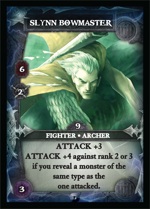 Several of the new heroes introduced in DL allow for more
player-versus-player cards. The Sidhe are one of the more interesting
examples of effect interaction in DL. If you would normally gain
a Disease while a Sidhe is in your hand, you get to pass the Disease to
another player instead. Other Heroes, while not allowing this level of
controlled decision making, still allow you to occasionally needle your
opponents effectively, such as the Verdan race's ability to make other
players each discard a card from hand.
Several of the new heroes introduced in DL allow for more
player-versus-player cards. The Sidhe are one of the more interesting
examples of effect interaction in DL. If you would normally gain
a Disease while a Sidhe is in your hand, you get to pass the Disease to
another player instead. Other Heroes, while not allowing this level of
controlled decision making, still allow you to occasionally needle your
opponents effectively, such as the Verdan race's ability to make other
players each discard a card from hand.
There are five new Monsters introduced in this set. Two of them hand
out cards from the new Special Disease deck. One of these, the Swarm,
is merely a slight revamp of the Horde monster from the WE
expansion. Each Swarm animal is more difficult to defeat than the last
one that appeared in the game, and the number of Experience Points you
gain for each Swarm is equal to the total number of Swarm cards in your
deck at the end of the game (up to a maximum of 5 points per card).
Each Swarm grants you a Trophy effect of +1 to Attack, but offsets that
by giving you a card from the Special Disease deck. Clearly hunting the
Swarm down with members of the Sidhe race gives you all the positives
and none of the negatives. This interaction is one of the more
interesting types of intra-set synergy in the DL expansion.
Components & Packaging
The art on the cards in this expansion is top notch. While some of it
simply displays more and different monsters for the players to fight,
thematically some cards are more tightly tied into the expansion's
backstory than others. For example, there are cards for the cultists
who worship the Stone of Avarice, though surprisingly none of them are
"in frame" with the Thunderstone itself. There are also some great
cards displaying evil druids, who presumably want the Stone of Avarice
for themselves. These druids sow disease and death in their path
instead of merely encouraging green grass and trees to grow. In spite
of all of the fine card images, AEG still has not done anything to
update the iconography on the game cards to make them easier to
interpret for beginners.
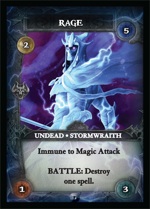 The art of the box itself is quite good as well, although the package
art is dark and low contrast, so it doesn't visually "pop" the way the
WE box did. The image of the box included in this article is
substantially more vibrant than the actual box art that resulted from
the printing process.
The art of the box itself is quite good as well, although the package
art is dark and low contrast, so it doesn't visually "pop" the way the
WE box did. The image of the box included in this article is
substantially more vibrant than the actual box art that resulted from
the printing process.
The card stock for the cards has a nice spring for shuffling and a good
"slip". The card backs are very slightly different than previous
expansions, but they match closely enough that many players will not
detect a difference.
The 16-page rulebook is fairly clear. I found one card, "The
Bloodless", that made me guess how to resolve part of it. Some cards
are now both Weapons and Items. Since Weapons have to be equipped to a
single Hero to function and Items don't, this caused me enough confusion
that I wish it would have received greater attention in the rulebook.
Another thing that threw me was the setup information included for your
first game with this expansion: in the rulebook "Border Guard" was
listed as "Bodyguard" and "Doomgate Squire" was listed as "Squire".
Since I have the cards alphabetized this confused me for a minute, but I
soon puzzled it out.
DL comes with a new box that is the same size as the WE
box. This time, however, only 28 index-tabbed dividers are included for
the new cards. Players looking for dividers for their base TS
cards will have to buy WE. Each divider has the name of the card
it is supposed to be filed with. These dividers are noticeably taller
than the game cards, unlike the non-tabbed dividers in the base
TS set, which were barely taller than the game cards and had no
names on them. The new tabbed dividers keep the cards easy to find,
while sponge blocks keep categories of cards separate from each other
(like Village cards and Heroes), and keep the cards from moving in the
box during transport. The blocks are obviously removable to allow for
further expansion cards to fit in this storage box. I managed to get
all of my TS cards into one box. If you use thin card sleeves
you may be able to remove the foam blocks and sleeve your cards as well,
though the DL box will limit the thickness and length of the
sleeves that may be used while still managing to store everything in one
box.
Conclusions
Doomgate Legion is net positive overall as an expansion, but it
is not without its drawbacks. Many of the monsters are immune to magic,
and yet many of the Village cards improve spells and spell casters.
Some cards are simply minor variants on old cards, feeling like AEG did
not push their design space as much as they could with this expansion.
Factors like these, and having a Pious Chaplain without
disease-generating monsters can occasionally limit interesting
deck-building decisions, can sometimes cause the procession of monsters
in the Dungeon Hall to stall, and can potentially lengthen an already
long multi-player game. I think with this expansion more than with
WE, players may need to hand tweak their starting Village cards,
Heroes, and Monsters more often instead of entirely randomizing them as
intended. If you are willing to do this periodically, then a number of
the failings of the set can be ignored, and DL will be a good fit
for your TS game collection. If you have got the money for just
one Thunderstone expansion, pick up Wrath of the Elements
instead. If you can afford both, Doomgate Legion will be a nice
addition to the mechanics and the packaging introduced in Wrath of
the Elements.
For Retailers
While the packaging is great, since the price for DL is $5.00 more
expensive than WE and comes with only a fraction of the dividers,
this product won't have the same "must have" quality about it that
WE did. TS is a popular game and its expansions will
sell, but you may sell slightly less of this set than you did of
WE.
Lee's Ratings:
Overall: B+
Gameplay: B
Artwork: A
Rules Clarity: B+
Card Layout: B (due to lack of useful iconography on some cards)
Packaging: A
Retailer Salability: B (or lower, if Wrath of the Elements was not a strong seller for you)
Links
| Similar reviews on OgreCave: |
|
|


 Thunderstone: Doomgate Legion
Thunderstone: Doomgate Legion The Special Disease deck features ten standard disease cards that simply
penalize you with a -1 to your Dungeon Attack rating, but there are also
15 new special Diseases. These include a variety of debilitating
effects, from making your Village purchases more expensive to cards that
cost you Victory Points at the end of the game. Unlike traditional
Diseases, when the Special Disease deck is utilized the deck is kept
face down and Diseases are handed out at random. This means that it's a
bit tougher to blithely attack a monster that gives you a Disease card
in Battle. Two of the new monsters introduced in the set require that
you play with the Special Disease deck, but it can also be added at any
time to increase the game's difficulty and length.
The Special Disease deck features ten standard disease cards that simply
penalize you with a -1 to your Dungeon Attack rating, but there are also
15 new special Diseases. These include a variety of debilitating
effects, from making your Village purchases more expensive to cards that
cost you Victory Points at the end of the game. Unlike traditional
Diseases, when the Special Disease deck is utilized the deck is kept
face down and Diseases are handed out at random. This means that it's a
bit tougher to blithely attack a monster that gives you a Disease card
in Battle. Two of the new monsters introduced in the set require that
you play with the Special Disease deck, but it can also be added at any
time to increase the game's difficulty and length.
 Treasure cards are nearly polar opposites of the Trap cards from the
Wrath of the Elements (WE) expansion. Treasure cards are
shuffled into the Dungeon Deck and randomly appear in the Dungeon Hall
from time to time. These cards are immediately collected by the active
player, and do not go into his deck, but are instead set in front of him
for the rest of the game until they are used. Each one grants a
one-shot game effect that can be cashed in during any future turn of the
game. Treasure cards can even be acquired when you fail to defeat a
monster, an idea that seems counter to the dungeon-delving theme. They
are an interesting addition to the game in that they encourage players
to enter the Dungeon Hall even to unsuccessfully encounter a monster,
helping to keep the Dungeon Hall from remaining too stagnant if all the
monsters are too powerful to kill. Ideally, though, Treasure cards
should have been kept separate from the Dungeon Deck and tied to a
Spoils effect of some kind on particularly difficult monsters to
encourage you to fight them. As it is, since they appear at random, I
question the game balance effects these items can have on the game, but
as their effects are modest and one-shot in nature, I'm not willing to
count them out just yet.
Treasure cards are nearly polar opposites of the Trap cards from the
Wrath of the Elements (WE) expansion. Treasure cards are
shuffled into the Dungeon Deck and randomly appear in the Dungeon Hall
from time to time. These cards are immediately collected by the active
player, and do not go into his deck, but are instead set in front of him
for the rest of the game until they are used. Each one grants a
one-shot game effect that can be cashed in during any future turn of the
game. Treasure cards can even be acquired when you fail to defeat a
monster, an idea that seems counter to the dungeon-delving theme. They
are an interesting addition to the game in that they encourage players
to enter the Dungeon Hall even to unsuccessfully encounter a monster,
helping to keep the Dungeon Hall from remaining too stagnant if all the
monsters are too powerful to kill. Ideally, though, Treasure cards
should have been kept separate from the Dungeon Deck and tied to a
Spoils effect of some kind on particularly difficult monsters to
encourage you to fight them. As it is, since they appear at random, I
question the game balance effects these items can have on the game, but
as their effects are modest and one-shot in nature, I'm not willing to
count them out just yet.
 Several of the new heroes introduced in DL allow for more
player-versus-player cards. The Sidhe are one of the more interesting
examples of effect interaction in DL. If you would normally gain
a Disease while a Sidhe is in your hand, you get to pass the Disease to
another player instead. Other Heroes, while not allowing this level of
controlled decision making, still allow you to occasionally needle your
opponents effectively, such as the Verdan race's ability to make other
players each discard a card from hand.
Several of the new heroes introduced in DL allow for more
player-versus-player cards. The Sidhe are one of the more interesting
examples of effect interaction in DL. If you would normally gain
a Disease while a Sidhe is in your hand, you get to pass the Disease to
another player instead. Other Heroes, while not allowing this level of
controlled decision making, still allow you to occasionally needle your
opponents effectively, such as the Verdan race's ability to make other
players each discard a card from hand.
 The art of the box itself is quite good as well, although the package
art is dark and low contrast, so it doesn't visually "pop" the way the
WE box did. The image of the box included in this article is
substantially more vibrant than the actual box art that resulted from
the printing process.
The art of the box itself is quite good as well, although the package
art is dark and low contrast, so it doesn't visually "pop" the way the
WE box did. The image of the box included in this article is
substantially more vibrant than the actual box art that resulted from
the printing process.